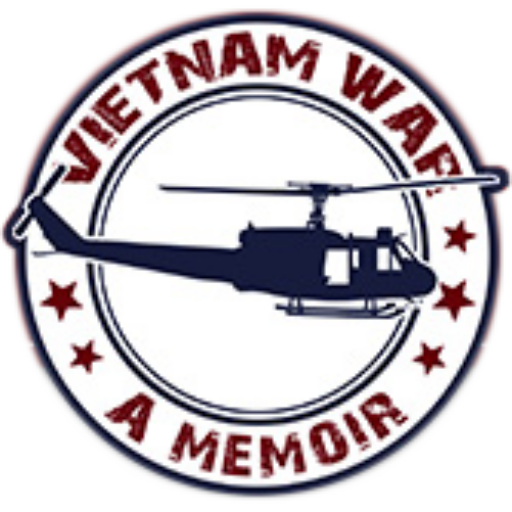Home » History of Vietnam » Tet Offensive » Battle of Hue
Battle of Hue
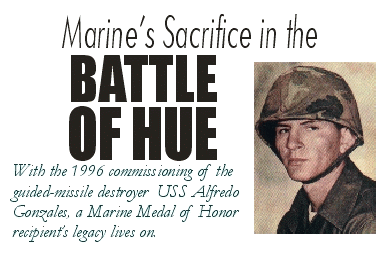
By John W. Flores
Twelve enemy soldiers, armed with B-40 rocket propelled grenades, moved stealthily through the underbrush that lined the edge of the schoolyard of the Jeann d’Arc High School and Church complex, located on the edge of Hue City. They took cover as 38-man U.S. Marine force approached their position across an open field on the opposite side of the church. A violent and bloody showdown was imminent.
It was the morning of February 4, 1968, five days after the NVA and VC had overrun Hue, the old Imperial capital of Vietnam, at the beginning of their Tet Offensive. The Marines were from the 3rd Platoon, Alpha Company, 1st Battalion, 1st Marine Regiment (1/1), commanded by Sergeant Alfredo “Freddy” Gonzalez, a 21 year-old Marine from Edinburg, Texas. He had taken charge several days earlier after the lieutenant who normally commanded the platoon had been wounded and evacuated.
Gonzalez had enlisted in the Marines three years earlier, in May 1965, just after graduating from high school. He had always wanted to be a Marine from the time he was a small boy, according to his mother, Dolia Gonzalez, who still lives in Edinburg. Often, while watching John Wayne war movies at the town theater on Saturday afternoons, he would nudge his mother, cup his hand to her ear and whisper, “Someday I’m going to be a Marine just like that.”
After boot camp, Gonzalez served a one-year tour in Vietnam in 1966-67. “Freddy had just completed one tour of duty, and he’d made it back home,” recalled J.J. Avila, a close friend of Gonzalez’s who also served as a Marine in Vietnam. “He was on leave, and I remember he called me over to his house and said he had had a serious dilemma. He had just gotten word that a platoon of men he had served with in Vietnam had been blown away in an ambush.” Gonzalez told Avila he believed that he could have kept the men alive had he been at the scene. “And he had reason to be so confident,” said Avila. “He saved many men through his coolness under fire, a calculating, rapid-fire courage, and a big-brother’s concern for his men.” Avila continued: “I told Freddy, “Do not go back. You’ve done your duty.” He said he did not want to go back. He’s seen enough of the war, and he wanted to be close to home to take care of his mother. But the ambush really hit him hard. Finally, I knew it was no use. He’d made up his mind, and there was no changing it. I told him he’d already done his duty, but if he had to go back, just be careful. Just come back home.”
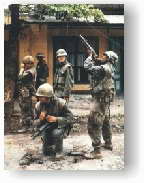
When Gonzalez returned to Vietnam he was assigned to Alpha Company, 1/1. In January 1968 the men had just come off duty along the DMZ at Con Thien and had moved south to the provincial capital at Quang Tri. “I had no other officers with me,” recalled retired Marine Colonel Gordon Batcheller, who then a captain had taken command of Alpha Company on Christmas Day 1967. “They were all gone. Sergeant Gonzalez was commander of the 3rd Platoon. We were ordered as part of a large-scale movement down to Phu Bai, outside of Hue, the night before the Tet Offensive started on January 30. We were alerted we would be a reaction force, then I got blown away with an automatic weapon of some kind going into Hue and was medevaced out.”
Lieutenant (now Maj. Gen.) Ray Smith, who took command of Alpha Company after Batcheller was wounded, was impressed with platoon leader Gonzalez. “The thing that probably is most surprising and maybe says a lot about him is that I thought of Sergeant Gonzalez as an old veteran,” said Smith, “At the time, I mean, I remember thinking of Sergeant Gonzalez as an old-timer, a guy who had been around a while. I was just 21, and as it turned out he was four or five months younger than me. I remember him as a real mature, grown-up sergeant type of a guy, as opposed to the 21 year-old that he was. He was a real quite person, but he always had a smile on his face. He was a little restrained in his emotions, but that was probably because he was truly one of the ‘grown-ups’ in our organization.”
“I primarily knew him on a personal basis, because in November and December 1967 in Quang Tri we had an officer and staff NCO card game,” continued Smith. “We would gather in the company commander’s bunker and play penny ante poker. You had to be an officer or a staff NCO to be involved in that card game, but we made an exception for Gonzalez because he was to us a grown-up among those kids. Like a lot of people that you remember for their actions, my memory of him is as a big muscular guy. He was actually fairly small. I’m 6’feet-2″ inches tall and 218 pounds. Recently a friend sent me a photo of Sergeant Gonzalez and I standing beside each other. I couldn’t believe I was that much bigger than him. It was just the opposite in my memory. He was the big one.”
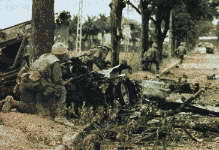
During the advance into Hue City, Gonzalez was wounded twice by machine-gun and mortar fire. At one point, when Gonzalez and other Marines became targets of sniper fire, they took cover behind an armoured vehicle that was rolling along ahead of the platoon. One of the privates under Gonzalez’s command was hit and went down on the road ahead. Gonzalez jumped from behind the tank and sprayed fire at a VC machine-gun bunker that was hidden amid the heavy foliage along the dirt road. While some members of his platoon were momentary stunned by Gonzalez’s bold move, others raked the machine-gun nest with automatic-weapons fire. Before the sergeant reached the badly wounded Marine 20 or 30 yards ahead, he made his way along a narrow ditch until he was near the bunker. He then lobbed two grenades inside, and the explosions killed the enemy soldiers in the bunker. Gonzalez then made his way back to the wounded private, heaved his 170-pound body over his shoulder and ran back towards the cover of the tank. Although hit by bullet fragments and mortar shrapnel from other enemy troops and bleeding badly, Gonzalez managed to reach the tank.
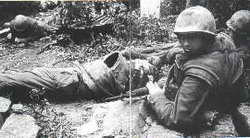
A Navy corpsman rushed to administer to Gonzalez and the dying Marine he had tried to save and ordered the sergeant to leave by medevac chopper. But Gonzalez would have none of it, according to Smith. These were his men, and he refused to leave them. As Gonzalez’s boss, Smith tried to get another sergeant to take command of the 3rd Platoon while the company continued its advance on Hue City. But nobody challenged Gonzalez’s decision to fight on. According to Smith, “The gunnery sergeant said, “Lieutenant, I’ll go and follow Sergeant Gonzalez around if you want me to, but he is in command of 3rd Platoon.” He said he was going to put him in for the Medal of Honor if we survived. Always seen as a good solid, lead-by example Marine, when we entered the fight in Hue City, Gonzalez became way more than that. for the next few days he became almost a one-man army. All of us who survived remain in awe of him.”
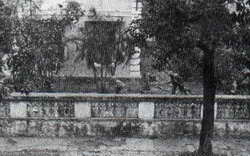
On February 4, 1968, as smith later recalled, “the first objective of the company was the St. Joan of Arc School and church only about 100 yards away.” It was a key position that both sides wanted because it could serve as a protective bulwark during the fighting. “The building was square, with an open compound in the middle,” recalled Smith, “and we found that by 0700 hours it was heavily occupied.” Sergeant Gonzalez ordered his platoon to keep down, out of the line of fire, while he surveyed the situation. Meanwhile Lieutenant Smith and the remainder of Alpha Company entered the school.
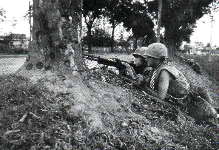
Suddenly a fire storm erupted. Many of the Marines fell dead or wounded from machine-gun and rocket fire, and platoons from scattering like pool balls after a break, with bullets whizzing inches above the men’s helmets. Only a handful were already inside the church and school corridors, and those who had fanned out to take cover were under intense fire. “We were trying to secure the church,” said Smith, “and the enemy was inside the school. We had to blow holes in the walls so we could get through and take the school rooms. It was very tough fighting.” Smith’s Marines found themselves engaged in room-to-room combat.
Lieutenant Colonel Marcus Gravel, the battalion commander of the 1/1, said that in the convent building the Marines proceeded from wall to wall. “One Marine would place a plastic C-4 charge against the wall, stand back, and then a fire team would rush through the gaping hole. In the school building Sergeant Gonzalez’s 3rd Platoon secured one wing but came under enemy rocket fire from across the courtyard.” Although still suffering from his earlier wounds, Sergeant Gonzalez managed to grab a handful of LAW’s (M-72 light antitank weapons) and positioned himself on the second floor of the school, firing at enemy positions from one window to another,” said Smith. “He had managed to take out several of the enemy positions when a rocket was fired at him and hit him in the midsection.”
Lawrence “Little Larry” Lewis of Chattanooga, Tenn., a rifleman in Gonzalez platoon, was only a few feet away from the sergeant when he was hit. Lewis had arrived in Vietnam in September 1967 and was terribly frightened he would be killed. Sergeant Gonzalez had noticed that he was upset and had talked to the young man and put him at ease. When Gonzalez went down, Lewis pulled him out of the line of fire and laid him on a door. “His heart was still beating,” Lewis recalled, “but he was died a short time later. O couldn’t believe he was hit. He was hero to us all, and took care of us young guys when we got in country.”
Gonzalez was a hero to his country as well. In 1969, his mother Dolia Gonzalez, was escorted to the White House to receive the Medal of Honor awarded to her son posthumously. Signed by President Richard Nixon and presented by Vice President Spiro Agnew, the official citation read:
“For conspicuous gallantry and intrepidity at the risk of his life above and beyond the call of duty while serving as Platoon Commander, Third Platoon, Company A, First Battalion, first marines, first Marine Division, in the Republic of Vietnam. On 31 January 1968, during the initial phase of Operation Hue City, Sergeant Gonzalez’s unit was formed as a reaction force and deployed to Hue to relieve the pressures on the beleaguered city. While moving by truck convoy along Route #1, near the village of Lang Van Long, the Marines received a heavy volume of enemy fire. Sergeant Gonzalez aggressively maneuvered the Marines in his platoon, and directed their fire until the area was cleared of snipers. Immediately after crossing a river south of Hue, the column was again hit by intense enemy fire. One of the Marines on top of a tank was wounded and fell to the ground in an exposed position. With complete disregard for his own safety, Sergeant Gonzalez ran through the fire-swept area to the assistance of his injured comrade. He lifted him up and though receiving fragmentation wounds during the rescue, he carried the wounded Marine to a covered position for treatment. Due to the increased volume and accuracy of enemy fire from fortified machine-gun bunker on the other side of the road, the company was temporarily halted. Realizing the gravity of the situation, Sergeant Gonzalez exposed himself to the enemy fire and moved his platoon along the East side of a bordering rice paddy to a dike directly from the bunker. Though fully aware of the danger involved, he moved to the fire-swept road and destroyed the hostile position with hand grenades. Although seriously wounded again on 3 February, the enemy had again pinned the company down, inflicting heavy casualties with automatic weapons and rocket fire. Sergeant Gonzalez, utilizing a number of light antitank assault weapons, fearlessly moved from position to position firing numerous rounds at the heavily fortified enemy emplacements. He successfully knocked out a rocket position and suppressed much of the enemy fire before falling mortally wounded. The heroism, courage, and dynamic leadership displayed by Sergeant Gonzalez reflects great credit upon himself and the Marine Corps and were in keeping with the highest traditions of the United States Naval Service. He gallantly gave his life for his country.”
That was not the only honor that Sergeant Gonzalez received. In 1975 an elementary school in his hometown of Edinburg, was named in his honor, and in 1993 Navy Secretary John Dalton announced that the Navy’s most advanced and one of its deadliest warships would be named after him. USS Alfredo Gonzalez (DDG-66), a guided-missle destroyer, was christened at Bath, Main, in February 1995 and commissioned at Corpus Christi, Texas, in October 1996. The first modern warship named for a Mexican-American, she is now serving with the Navy’s Atlantic Fleet.
John Flores, a Coast Guard veteran, writes from Texas. For further reading: Phase Line Green: The Battle for Hue, 1968, by Nicholas Warr (Naval Institute Press); and U.S. Marines in Vietnam: The Defining Year 1968, by Jack Shulimson et al. (USMC History and Museums Division.
